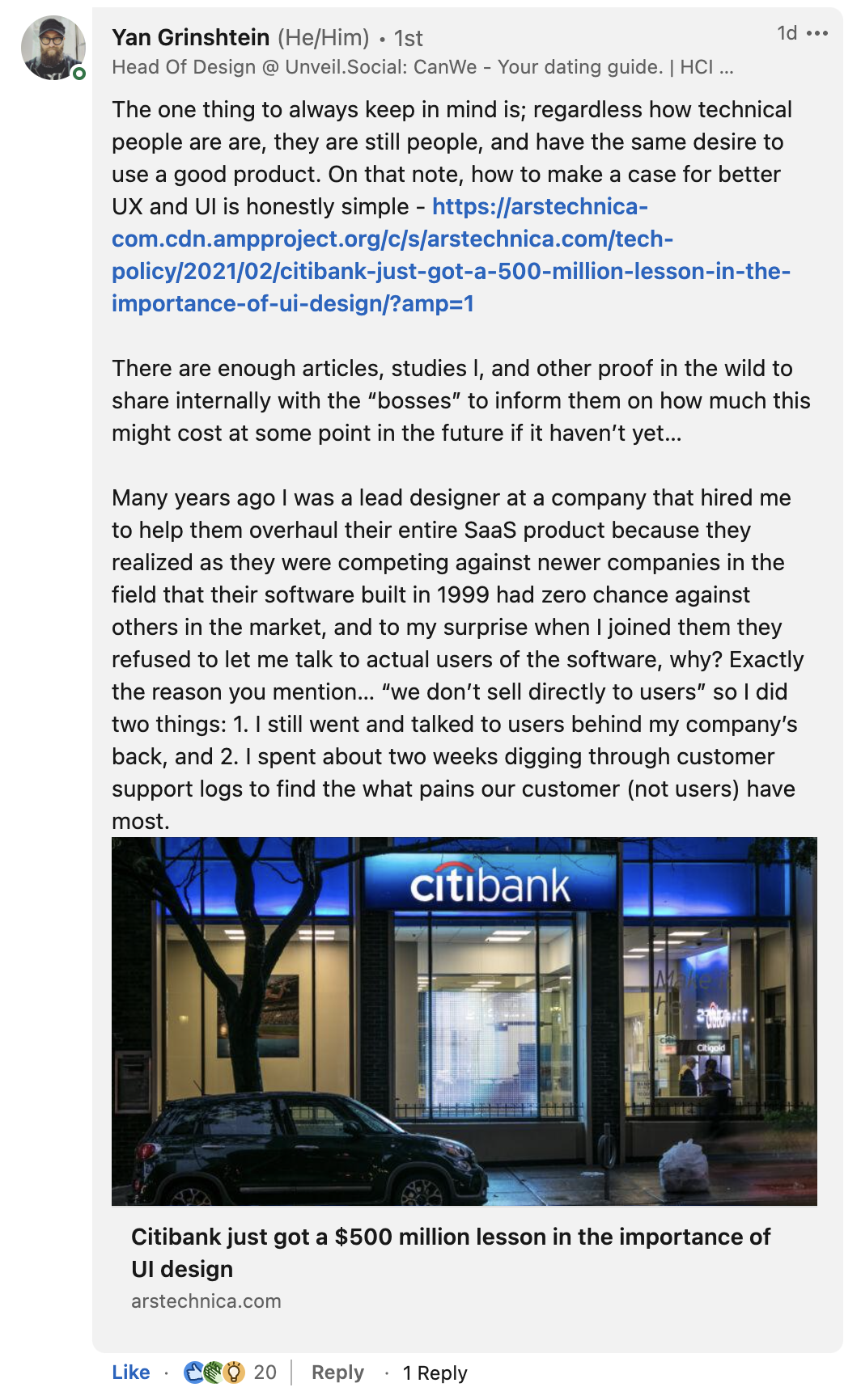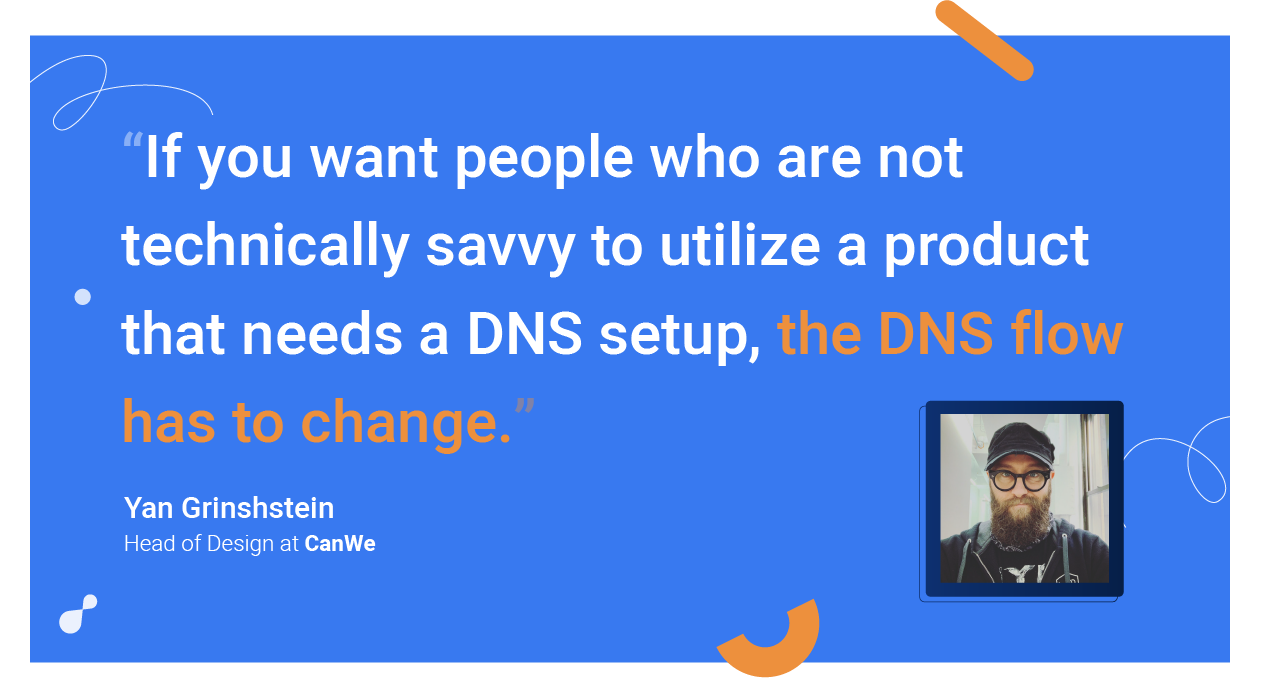Yan Grinshtein is the strongest design leader I know. He’s smart, holistic in his view of product design, and a fierce advocate for the end-user. When I sat down with him to talk about DNS in the platform user experience, I knew that he would have some strong opinions about it.
Yan comes from a long track record in product design, and is one of the only true masters of the art that I’ve ever met. He holds a Human-Computer Interaction (HCI) certificate from MIT, a certificate for accessibility in user experience, and over the last 25 years, has launched over 400 projects. He’s spent time in the trenches doing research and understands the data that informs good design decisions.
He’s a master, and if there’s one thing Yan has no tolerance for, it’s a shitty user experience.
DNS setup: the dinosaur of the modern UX

Yan and I worked together very briefly at a time when he was consolidating an onboarding flow in a product. If there was one thing I remember well from those days, it was his adamance that every unnecessary step and form field be culled.
So when I reached out to him to ask him for his opinions on DNS configuration in product onboarding, I knew I was in for a good sermon.
Because in the last 20-some years, DNS configuration has remained relatively untouched. You buy your domain, you set up your account on a platform provider, and then you panic as you try to remember who your host is, and try to figure out how to not screw up this critical and essential process.
For admins and developers, this process is a pain, but simple enough. For non-technical users though, it’s a problem nearly every time.
“I can tell you right now for a fact – and you are probably not going to need to do any research – that if you're going to put a DNS setup in front of an average Joe to deploy something, they will not use it,” says Yan.
“If you want people who are not technically savvy to utilize a product that needs a DNS setup, the DNS flow has to change.”
Platform users are changing
Today’s generation of buyers and B2B end-users is made up largely of Millennials and Zoomers, and these generations do not have any patience for an unintuitive UI.
“Let's look at it from this perspective: if the product doesn't work, somebody in the older generation thinks to themselves, ‘Oh, crap, I don't know enough about this product or how to work it out’, right? For Gen X, if the product doesn't work, typically they try to figure it out. They're not going to ask for help. They're not going to read any manuals. They're just going to start trying to poke things and see what happens.
Now, the difference between the older two generations and the millennials and Gen Z's is that if the product doesn’t work, the younger generations immediately blame it on the product. And that's the difference.”
Now, if a product’s UI isn’t intuitive, it dies on the vine.
DNS configuration has always been an inescapable part of setting up a new website, but until this point in our history, it has arguably never created more friction in the user experience.
Admins are no longer the ones solely responsible for setting up websites and technology solutions.
In the wake of codeless environments, creators and every day non-technical users are now the ones buying domains and setting up online stores. They’re also the ones getting held up as they try to figure out what a domain registrar is and how the hell to port over their CNAME records.
DNS has created what any product designer would deem an unacceptable barrier to product adoption. Until Entri, there was very little that anyone could do about that.
Why is manual DNS configuration still a thing?

Over the course of the last ten years, the product design mindset has shifted from a “figure it out” mentality, to building designs that even toddlers with gross motor function can figure out.
But in the midst of all that digital transformation, some areas have been stubborn to correct. And one has to wonder, how is that even possible? How are we talking about web3, and still manually configuring our DNS records? How do archaic flows survive in spite of every piece of evidence pointing to the need to update them?
“The question is, did the solution not exist because of some issue or problem or hurdle, or because no one actually just bothered to figure it out?”
Some companies never improve their product experiences because they simply don’t have to – they have no competitors, or their users are tolerant of a poor UI because their needs are so specific, that they’re rendered with very few alternative options.
But still, other organizations will struggle to improve a product simply because the reform that’s needed is too heavy of an engineering lift to perform in-house, and does not exist on the market yet.
When we spoke with one of our customers here at Entri, even he said that he had considered building a DNS solution like Entri at one point, because the configuration was creating too much friction for his users.
But it was too costly and too complex, so the project never started (we’re really glad we found him). You can read Baptiste’s full story here.
The cost of unintuitive product design
We started Entri because we saw one of these archaic product experiences, and knew that it was time to topple the giant. Today’s B2B users have less patience than ever for unintuitive UI, and for companies that leave these products to sit untouched, there is a measurable loss in users and revenue to be felt for it.
“If these things are not being adopted and not being utilized or implemented in a timely manner, then companies are losing customers or users like flies.”
Looking at product metrics, we can measure the actual cost of a poor UI by customer dropoff or retention. When we look at analytics, we can see where poor UI is literally costing a company money. When we run usability studies, we can see where a product isn’t just losing customers, but giving them negative feelings surrounding the product and the company. It’s hard to outrun that kind of sentiment.

They feel frustrated at the product, and they are not taking that frustration upon themselves as a learning opportunity, because today’s users expect them to be designed better.
It may not be today, and it may not be tomorrow, but even in cases where a product needs to be complex to meet the complex needs of its use case, product UIs that don’t adapt will eventually be outdone by a competitor who smells the opportunity.
Let your users inform your product roadmap
Cross-functional product development creates applications that users thrive on. When sales, customer support, and product design get in the same room together, that’s when the magic happens. When something trending on Twitter becomes more of a priority than a growing caseload of support tickets, then a priority shift needs to occur.
The next big thing in SaaS may not be a big thing at all – it may just be making technology even more accessible, with better product experiences. A storefront on the metaverse isn’t likely to solve for the friction points in your product now.
“If a company wants to survive and wants to continue to innovate and wants to continue to be in line with the future of their users, they have to constantly research and understand their users. Not necessarily the market, not necessarily the environment, not necessarily what is the next hottest trend, but figure out where the user is and where they go. That's really all they need to know.”
